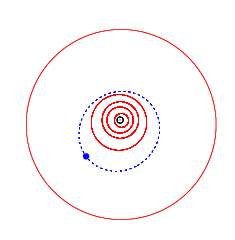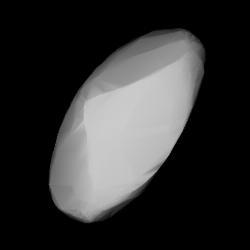Related Research Articles

2830 Greenwich is a bright Phocaea asteroid from the inner regions of the asteroid belt. It was discovered on 14 April 1980, by American astronomer Edward Bowell at Lowell's U.S. Anderson Mesa Station, Arizona, and named for the historical Royal Greenwich Observatory in England. The stony S-type asteroid has a long rotation period of 24 hours and measures approximately 9 kilometers in diameter
1575 Winifred, provisional designation 1950 HH, is a stony Phocaea asteroid and slow rotator from the inner regions of the asteroid belt, approximately 9.5 kilometers in diameter.
6433 Enya, provisional designation 1978 WC, is a stony background asteroid from the inner regions of the asteroid belt, approximately 7 kilometers in diameter. It was discovered on 18 November 1978, by Czech astronomer Antonín Mrkos at the Kleť Observatory in the Czech Republic. It was named for Irish musician Enya.

9963 Sandage, provisional designation 1992 AN, is a stony Phocaea asteroid from the inner regions of the asteroid belt, approximately 6 kilometers in diameter.
6398 Timhunter, provisional designation 1991 CD1, is a stony Phocaea asteroid from the inner regions of the asteroid belt, approximately 5.5 kilometers in diameter. It was discovered on 10 February 1991, by American astronomer couple Carolyn and Eugene Shoemaker, in collaboration with Canadian astronomer David H. Levy at Palomar Observatory in California, United States. It was named for American amateur astronomer Tim Hunter.
4899 Candace, provisional designation 1988 JU, is a background asteroid from the inner regions of the asteroid belt, approximately 7 kilometers in diameter. It was discovered on 9 May 1988, by astronomer couple Carolyn and Eugene Shoemaker at the Palomar Observatory in California, United States. The asteroid was named after American chemist Candace Kohl.

1568 Aisleen, provisional designation 1946 QB, is a stony Phocaea asteroid from the inner regions of the asteroid belt, approximately 12.5 kilometers in diameter. It was discovered on 21 August 1946, by South African astronomer Ernest Johnson at Johannesburg Observatory in South Africa. It is named for the discoverer's wife, Aisleen Johnson.

2839 Annette is a bright Flora asteroid from the inner regions of the asteroid belt. It was discovered on 5 October 1929, by American astronomer Clyde Tombaugh at Lowell Observatory during his search for Pluto. The presumed S-type asteroid has a rotation period of 10.5 hours and measures approximately 5 kilometers in diameter. It was named after the discoverer's daughter.
11277 Ballard, provisional designation 1988 TW2, is a Phocaea asteroid from the inner regions of the asteroid belt, approximately 6.3 kilometers (3.9 miles) in diameter. It was discovered on 8 October 1988, by American astronomer couple Carolyn and Eugene Shoemaker at the Palomar Observatory in California. The assumed S-type asteroid has a rotation period of at least 10 hours. It was named for American marine scientist Robert Ballard.
4340 Dence, provisional designation 1986 JZ, is a background or Phocaea asteroid from the inner regions of the asteroid belt, approximately 8 kilometers in diameter. It was discovered on 4 May 1986, by American astronomer Carolyn Shoemaker at the Palomar Observatory in California. The S-type asteroid has a rotation period of 7.5 hours. It was named after Canadian geologist Michael R. Dence.
2571 Geisei, provisional designation 1981 UC, is a stony Florian asteroid from the inner regions of the asteroid belt, approximately 6 kilometers in diameter. It was discovered by Japanese astronomer Tsutomu Seki at Geisei Observatory on 23 October 1981, and named for the Japanese village of Geisei.

1987 Kaplan, provisional designation 1952 RH, is a stony Phocaea asteroid from the inner regions of the asteroid belt, approximately 14 kilometers in diameter. It was discovered on 11 September 1952, by Soviet astronomer Pelageya Shajn at the Simeiz Observatory on the Crimean peninsula. The asteroid was named after Soviet astrophysicist Samuil Kaplan.
19763 Klimesh, provisional designation 2000 MC, is a stony Phocaea asteroid and slow rotator from the inner regions of the asteroid belt, approximately 7 kilometers in diameter. Discovered by NEAT at Haleakala Observatory in 2000, the asteroid was named for NEAT's software specialist Matthew Klimesh.
3322 Lidiya, provisional designation 1975 XY1, is a stony Phocaea asteroid and potentially slow rotator from the inner regions of the asteroid belt, approximately 7 kilometers in diameter. It was discovered on 1 December 1975, by Soviet astronomer Tamara Smirnova at the Crimean Astrophysical Observatory in Nauchnij, on the Crimean peninsula. The asteroid was named after Russian aviator Lidiya Zvereva.
5430 Luu, provisional designation 1988 JA1, is a stony Phocaea asteroid from the inner regions of the asteroid belt, approximately 7 kilometers in diameter. It was discovered on 12 May 1988, by American astronomer couple Carolyn and Eugene Shoemaker at Palomar Observatory, California, and later named after astronomer Jane Luu.
13006 Schwaar, provisional designation 1983 AC1, is a stony Phocaea asteroid from the inner regions of the asteroid belt, approximately 5 kilometers in diameter. It was discovered on 12 January 1983, by American astronomer Brian Skiff at Lowell's Anderson Mesa Station in Flagstaff, Arizona. The asteroid was named after amateur astronomer Pierre–Yves Schwaar.
7776 Takeishi, provisional designation 1993 BF, is a background asteroid from the inner regions of the asteroid belt, approximately 6 kilometers in diameter. It was discovered on 20 January 1993, by Japanese astronomer Takeshi Urata at the Nihondaira Observatory in Japan. The assumed S-type asteroid has a rotation period of 8.9 hours. It was named after Japanese amateur astronomer Masanori Takeishi.
3823 Yorii, provisional designation 1988 EC1, is a carbonaceous asteroid from the outer region of the asteroid belt, approximately 11 kilometers in diameter.
4760 Jia-xiang, provisional designation 1981 GN1, is a background asteroid from the inner regions of the asteroid belt, approximately 5 kilometers (3 miles) in diameter. It was discovered on 1 April 1981, by astronomers at Harvard University's Oak Ridge Observatory in Massachusetts, United States. The presumed stony S-type asteroid was named after Chinese astronomer Zhang Jiaxiang. It has a rotation period of 14.96 hours.
1573 Väisälä, provisional designation 1949 UA, is a stony Phocaea asteroid, slow rotator and suspected tumbler from the inner regions of the asteroid belt, approximately 9 kilometers in diameter. It was discovered on 27 October 1949, by Belgian astronomer Sylvain Arend at the Royal Observatory of Belgium in Uccle, Belgium. It was named for Finnish astronomer Yrjö Väisälä.
References
- 1 2 3 4 "JPL Small-Body Database Browser: 23712 Willpatrick (1998 AA)" (2017-03-19 last obs.). Jet Propulsion Laboratory . Retrieved 27 June 2017.
- 1 2 3 Schmadel, Lutz D. (2006). "(23712) Willpatrick [2.38, 0.24, 23.5]". Dictionary of Minor Planet Names – (23712) Willpatrick, Addendum to Fifth Edition: 2003–2005. Springer Berlin Heidelberg. p. 186. doi:10.1007/978-3-540-34361-5_2175. ISBN 978-3-540-34360-8.
- 1 2 3 4 5 6 7 "LCDB Data for (23712) Willpatrick". Asteroid Lightcurve Database (LCDB). Retrieved 17 May 2016.
- 1 2 "Asteroid 23712 Willpatrick – Nesvorny HCM Asteroid Families V3.0". Small Bodies Data Ferret. Retrieved 27 October 2019.
- 1 2 3 4 Nugent, C. R.; Mainzer, A.; Bauer, J.; Cutri, R. M.; Kramer, E. A.; Grav, T.; et al. (September 2016). "NEOWISE Reactivation Mission Year Two: Asteroid Diameters and Albedos". The Astronomical Journal. 152 (3): 12. arXiv: 1606.08923 . Bibcode:2016AJ....152...63N. doi: 10.3847/0004-6256/152/3/63 .
- 1 2 3 4 Mainzer, A.; Grav, T.; Masiero, J.; Hand, E.; Bauer, J.; Tholen, D.; et al. (November 2011). "NEOWISE Studies of Spectrophotometrically Classified Asteroids: Preliminary Results". The Astrophysical Journal. 741 (2): 25. arXiv: 1109.6407 . Bibcode:2011ApJ...741...90M. doi:10.1088/0004-637X/741/2/90. S2CID 35447010 . Retrieved 17 May 2016.
- 1 2 3 Masiero, Joseph R.; Mainzer, A. K.; Grav, T.; Bauer, J. M.; Cutri, R. M.; Dailey, J.; et al. (November 2011). "Main Belt Asteroids with WISE/NEOWISE. I. Preliminary Albedos and Diameters". The Astrophysical Journal. 741 (2): 20. arXiv: 1109.4096 . Bibcode:2011ApJ...741...68M. doi:10.1088/0004-637X/741/2/68. S2CID 118745497 . Retrieved 3 December 2016.
- 1 2 Warner, Brian D. (June 2005). "Asteroid lightcurve analysis at the Palmer Divide Observatory - fall 2004". The Minor Planet Bulletin. 32 (2): 29–32. Bibcode:2005MPBu...32...29W. ISSN 1052-8091 . Retrieved 17 May 2016.
- ↑ Veres, Peter; Jedicke, Robert; Fitzsimmons, Alan; Denneau, Larry; Granvik, Mikael; Bolin, Bryce; et al. (November 2015). "Absolute magnitudes and slope parameters for 250,000 asteroids observed by Pan-STARRS PS1 - Preliminary results". Icarus. 261: 34–47. arXiv: 1506.00762 . Bibcode:2015Icar..261...34V. doi:10.1016/j.icarus.2015.08.007. S2CID 53493339 . Retrieved 17 May 2016.
- 1 2 "23712 Willpatrick (1998 AA)". Minor Planet Center. Retrieved 1 January 2016.
- ↑ "MPC/MPO/MPS Archive". Minor Planet Center. Retrieved 17 May 2016.